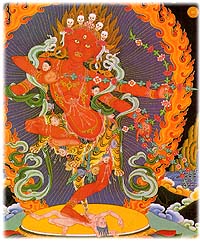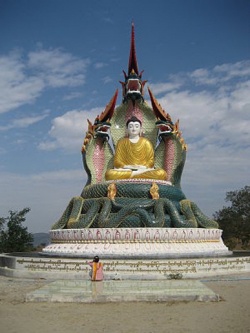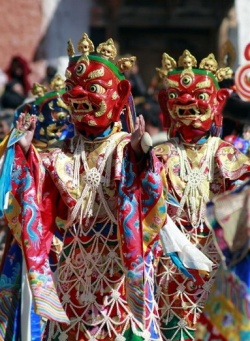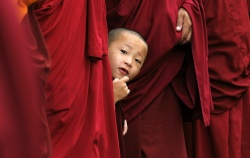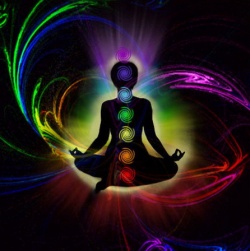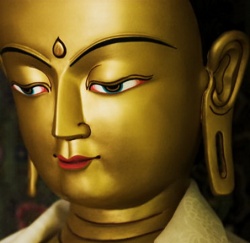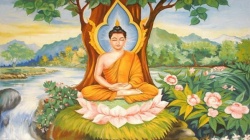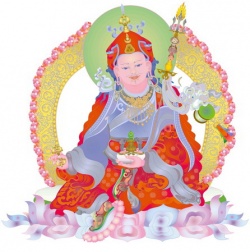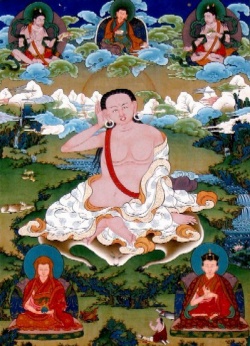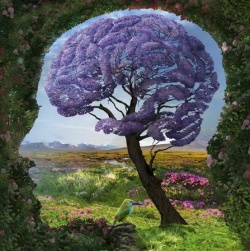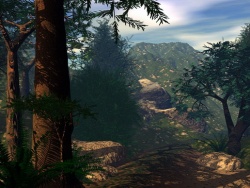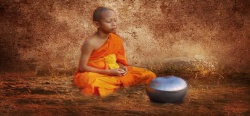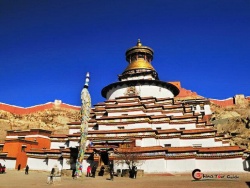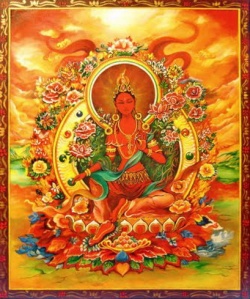Difference between revisions of "Getting to Know The Buddha"
| Line 55: | Line 55: | ||
After six years, {{Wiki|Prince}} [[Siddhartha]] reflected, "This is not the way to achieve [[enlightenment]]. This is an extreme, not the [[middle way]]. I must cut through my [[clinging]] to the {{Wiki|concept}} of [[asceticism]]. [[Asceticism]] itself has become a major obstacle at this point." To cut through the [[ego]] [[clinging]] of [[asceticism]], {{Wiki|Prince}} [[Siddhartha]] ended his [[ascetic]] practice. He bathed in the [[water]] of the [[river]], and then he partook of [[food]] that was [[offered]] to him. | After six years, {{Wiki|Prince}} [[Siddhartha]] reflected, "This is not the way to achieve [[enlightenment]]. This is an extreme, not the [[middle way]]. I must cut through my [[clinging]] to the {{Wiki|concept}} of [[asceticism]]. [[Asceticism]] itself has become a major obstacle at this point." To cut through the [[ego]] [[clinging]] of [[asceticism]], {{Wiki|Prince}} [[Siddhartha]] ended his [[ascetic]] practice. He bathed in the [[water]] of the [[river]], and then he partook of [[food]] that was [[offered]] to him. | ||
The [[Bodhi Tree]] | The [[Bodhi Tree]] | ||
| − | A beautiful young lady named [[Sujata]], who was living in the nearby city of [[Gaya]], [[offered]] the first [[food]] to {{Wiki|Prince}} [[Siddhartha]]. Her father belonged to one of the [[noble]] families in the city. On this particular day, her family had sent her to the [[river]] to make the customary [[offerings]] to the [[water]] [[deities]], the [[nagas]]. One of the [[offerings]] was a | + | A beautiful young lady named [[Sujata]], who was living in the nearby city of [[Gaya]], [[offered]] the first [[food]] to {{Wiki|Prince}} [[Siddhartha]]. Her father belonged to one of the [[noble]] families in the city. On this particular day, her family had sent her to the [[river]] to make the customary [[offerings]] to the [[water]] [[deities]], the [[nagas]]. One of the [[offerings]] was a dish made from milk and {{Wiki|rice}} called kir. So, [[Sujata]] was carrying a [[bowl]] of kir and many other [[offerings]] to the [[nagas]]. When she arrived at the [[river]], she saw an [[ascetic]] [[practitioner]], very thin and weak, lying on the ground in a faint, seemingly near [[death]]. She raised him up and sprinkled [[water]] on his face; slowly, he returned to [[consciousness]]. She [[offered]] him some kir, and [[Siddhartha]] ate all of it and asked for more. She gave him more {{Wiki|rice}}, and he asked for more, until she had no more. |
The moment that [[Siddhartha]] stepped out of the [[ascetic]] [[path]] and took [[food]], he broke the law of the [[ascetic]] [[path]] and practice. His five friends were very upset and [[angry]]. "How could you do that? How can you expect to attain [[liberation]] if you do not follow the rules of the [[ascetic]] practices?" they asked. "We {{Wiki|renounce}} you as our [[guru]], as our [[teacher]]. We will go on our own way," they said. Then the five [[disciples]] left [[Gaya]] and went to continue their practice of [[asceticism]] to a place now called [[Sarnath]] outside of [[Varanasi]]. After {{Wiki|Prince}} [[Siddhartha]] first received [[food]], he gradually regained his health and strength. He still practiced around the [[Gaya]] area in the jungle. He became friends with [[Sujata]], and he also made friends with the local boys and other local [[people]]. One day, the boy who herded the {{Wiki|buffalo}} and cut grass for them [[offered]] a pile of grass to {{Wiki|Prince}} [[Siddhartha]]. [[Siddhartha]] took an armful of [[kusha grass]] and walked to the [[Bodhi tree]]. There he spread the [[kusha grass]] as a seat under the [[Bodhi tree]] in [[Bodhgaya]], and he sat under that [[tree]] throughout the night. | The moment that [[Siddhartha]] stepped out of the [[ascetic]] [[path]] and took [[food]], he broke the law of the [[ascetic]] [[path]] and practice. His five friends were very upset and [[angry]]. "How could you do that? How can you expect to attain [[liberation]] if you do not follow the rules of the [[ascetic]] practices?" they asked. "We {{Wiki|renounce}} you as our [[guru]], as our [[teacher]]. We will go on our own way," they said. Then the five [[disciples]] left [[Gaya]] and went to continue their practice of [[asceticism]] to a place now called [[Sarnath]] outside of [[Varanasi]]. After {{Wiki|Prince}} [[Siddhartha]] first received [[food]], he gradually regained his health and strength. He still practiced around the [[Gaya]] area in the jungle. He became friends with [[Sujata]], and he also made friends with the local boys and other local [[people]]. One day, the boy who herded the {{Wiki|buffalo}} and cut grass for them [[offered]] a pile of grass to {{Wiki|Prince}} [[Siddhartha]]. [[Siddhartha]] took an armful of [[kusha grass]] and walked to the [[Bodhi tree]]. There he spread the [[kusha grass]] as a seat under the [[Bodhi tree]] in [[Bodhgaya]], and he sat under that [[tree]] throughout the night. | ||
Latest revision as of 19:45, 17 February 2014
by The Dzogchen Ponlop Rinpoche,
How should we understand all the myths and stories about the Buddha's life? It is said that whoever encountered Buddha, whether a king, a queen or a beggar in the street, felt comfortable with him. Everyone, no matter what their circumstances, felt that he was relating directly, fully and properly with them. Everyone who saw Buddha felt the same peacefulness when they were near this enlightened being. The Buddha of the sutras, or the Buddhist scriptures, is a fully enlightened human being. He is the most perfected human being, but he is seen very much as a human being. The Buddha gathers alms, eats food, and drinks water. He walks in the garden. He meditates. He sleeps. Buddha talks with his friends and students. People relate to him as a human being.
We often lack this understanding. Nowadays Buddha is a myth, someone who never lived, like King Arthur of England or Gesar of Ling from Tibet. Buddha was never like one of those mythic heroes, nor was he ever like any of the gods, such as Krishna or Ram. Buddha was very much a human being. He interacted with every kind of sentient beings, and worked directly with them. That is how we should remember Buddha, and that is how we can begin to understand the story of his life. The Birth of Prince Siddhartha
In the Hinayana tradition, which emphasizes the individual journey to enlightenment, Buddha is presented as an ordinary human being who came to this Earth with a full karmic history - just like the rest of us. He worked hard in this life following the spiritual journey, and at the end of his life he became a great arhat, a great enlightened being. According to the Mahayana teachings, which emphasize the accomplishment of enlightenment for the benefit of all sentient beings, the Buddha took birth as a bodhisattva many times before he was born in our world. A bodhisattva is one who has vowed to awaken completely, to attain Buddhahood, in order to help others awaken. The last life that Buddha took on this earth as a bodhisattva was that of Prince Siddhartha. When he was born here, he was born with the realization, the strength and the power of many lifetimes of bodhisattva practice.
Buddha, or Prince Siddhartha, was born in north India. His parents were from the ruling families of two small, neighboring kingdoms. His father was Shuddhodana,
His mother was Mahamaya, the younger daughter of Queen Lumbini and King Sihanu. King Shuddhodana married Mahamaya's elder sister, Gautami, as well. The beauty of these two princesses was so great that they were said to be like the illusory creations of the most skillful magician or most talented artist. Buddha's birth took place in a beautiful garden called "Lumbini." This garden was named after Buddha's grandmother on his mother's side, Queen Lumbini. One day when Queen Lumbini was traveling around the capital of her own small kingdom, she saw a beautiful shrine in a beautiful temple belonging to one of the ministers. She was so impressed by this temple, her husband the King built a very similar, but even more beautiful temple and park for her, which was named after her. It was in this temple and park that Lord Buddha was born.
Descent from Tushita Heaven
According to the Mahayana view, before Shakyamuni took birth at Lumbini, he was living in Tushita heaven, giving teaching to many thousands of bodhisattvas, including the bodhisattva Maitreya. At that time, the great bodhisattva who was to become the Buddha said, "It is time for me to take my last birth in samsara. It is time for me to go to Jambudvipa (planet earth), to take birth in the human realm and conquer the world with the nectar of dharma."
All the bodhisattva students were upset that he was leaving. They cried, "After you leave, we will be left here without a master. We will be left here without the nectar of dharma." They asked him to stay longer, saying that it was not the right time for him to take birth in the human realm. They said, "This is the worst possible time that you could take birth in Jambudvipa. It has the five poisons of passion, aggression, ignorance, jealousy and desire and is not a very pleasant place to be born. However, the bodhisattva said, "This is my aspiration—I want to take birth there and benefit those sentient beings on earth." It is said in the sutras that Buddhas are not born in inappropriate situations. This bodhisattva who became Buddha chose the particular situation of his birth very carefully: his father, his mother, the time and the place. Thus, according to the Mahayana view, Buddha chose the place of his birth and was born there according to his own wish and desire. Bodhisattvas and Buddhas take birth in order to benefit people, and they see the best time and way to accomplish it.
If Siddhartha had been born in the untouchable caste and had become enlightened, it would have been difficult in that Brahmin culture to benefit beings and expand his activities. It would have been difficult for a lower caste person to go up against the higher caste. But Buddha was born in splendor, as a great and wealthy prince with everything that he wanted. His renunciation of his wealth became a powerful and beneficial example for the higher class of wealthy people. Moreover, his birth as a prince benefited the low castes; through his status and example he was saying, "We of the higher castes are equivalent to the lower castes."
Buddha's Birth: Prophecies and Miracles
Ten months after his aspiration, the bodhisattva was conceived in Mahamaya's womb. At the time of his conception, Mahamaya had a beautiful dream of a white elephant approaching her and then dissolving into her body. At that time, she had two other fateful dreams, one of flying in the sky and another in which all sentient beings on earth were paying respect to her.
She told these dreams to a Brahmin sage. The sage then made a prophecy, saying those dreams foretold that she would have a beautiful son, who would possess all the marks of an enlightened being. These are known as the thirty-two major marks and eighty-four minor marks of the body of a Buddha. Soon after, Queen Mahamaya gave birth to a beautiful son.
There are many stories of miraculous occurrences at the time of Buddha's birth. There were beautiful light rays emanating from the grove of Lumbini, illuminating not only Lumbini, but also the city of Kapilavastu and all the surrounding cities. This light reached a cave where a great Brahmin meditator was practicing. Seeing the cave illuminated, the disciple of this great meditator asked, "What is this light? Where is it coming from? It is not the ordinary light of the sun. It is not the usual daylight." Then the great sage told his disciple, "This light is coming from the birth of an enlightened being. Therefore, you must go soon and pay respect to this enlightened being." In Lumbini grove the newborn baby Shakyamuni walked seven steps in each direction. When Buddha took those seven steps in each direction, he proclaimed that he was going to benefit all sentient beings, reaffirming his aspiration, and all the flowers in the garden bloomed at once.
Shakyamuni was born full of great promise, showing many great signs. King Shuddhodana and Queen Mahamaya went to a sage and requested a prophecy for their child. The sage told them, "There are only two possibilities. This child will either become a great conqueror, a great emperor of the country, or he will become a great sage and a great master of the spiritual path."
Hearing this, King Shuddhodana became worried. He did not want his son to become a sage and a great master. He wanted his son to become a great conqueror and Shakya king. Therefore, he named his child "Siddhartha," which means "all-accomplishing." A week after Prince Siddhartha was born, his mother passed away. After her death, he was raised by four nannies, as well as by his aunt and stepmother Gautami. He began his education at a very young age. The prince was trained in the five ancient Indian sciences. He was trained in astrology, medicine, grammar, and literature and in the various physical arts and sciences, such as the military arts of defense and conquest. The masters of these different sciences were embarrassed because Siddhartha mastered all the subjects instantly. He would say, "O.K. Let's go on to the next level. Let's go to the next subject," but the masters had already reached the limits of their own training.
Siddhartha was educated and grew to manhood in a beautiful palace in the city of Kapilavastu. The king created for his son a wonderful life in the palace, with every enjoyment to distract the young prince and to protect him from any pain and suffering. He hoped the prince would always remain within the palace and become a great emperor.
But Shakyamuni Buddha was already a great bodhisattva when he was born. He was born full of love and compassion, and as he grew to maturity, the signs of his bodhisattva realization continued to manifest themselves. The king and Queen Gautami, along with all the people in their court, raised Siddhartha beautifully; he became a handsome and compassionate young prince. Siddhartha was especially interested in the Vedas and the religious Brahmin culture of his day. Siddhartha took every opportunity to be with a monk, a sage or a Brahmin to expand his knowledge through discussion and argument.
King Shuddhodana began to notice that Siddhartha was paying considerable attention to learning the Vedas from the sages and monks. The King’s ministers noticed as well, and said, “Siddhartha is coming to the age where he can be married. If you marry Siddhartha, then he will be happy with family life and he will not think of becoming a monk or a follower of the spiritual tradition.” The king thought that this was a good idea; he shared this with the queen, who promised to convey these plans to Siddhartha. Siddhartha’s Marriage to Yashodhara
The King and Queen knew of a beautiful Shakya princess, Yashodhara, whom they hoped Siddhartha would wish to marry, and so they arranged a meeting. One day in Kapilavastu, a gymnastics competition was held, emphasizing skills of strength such as wrestling and archery. Yashodhara presented the trophy for winning this event, a rare and beautiful white elephant, which had been born in the city Vaishali, not far from Kapilavastu, and brought as a gift by the people of Vaishali. Siddhartha won the competition, and Yashodhara presented the elephant to him. She was respectful and spoke gently, “You deserve this trophy, for you have performed well.” At that point, Siddhartha’s cousin Devadatta became jealous, as he had won only the second prize. Not only was Devadatta jealous of Siddhartha’s accomplishment, but also of the beautiful Yashodhara’s attentions. As he was passing by, he struck the elephant hard on the feet. The elephant fell to the ground in great pain, one leg almost broken. Prince Siddhartha said to Devadatta, “That mischievous action was very serious.” Then Prince Siddhartha knelt down in front of the elephant, massaging him and trying to heal his pain. Slowly, the elephant stood up on his feet. Prince Siddhartha then rode the elephant around the whole city of Kapilavastu, in celebration of his winning the
But while the elephant was healed, Devadatta’s jealousy of his accomplished cousin would continue for the rest of his life. Later, Siddhartha’s mother and the king organized another meeting with Yashodhara in the form of a feast with hundreds of guests. After their meeting at the dinner party, Prince Siddhartha often met with Yashodhara on more informal occasions. Once, Siddhartha was touring his kingdom, to see how the peasants and the city people were doing. He was visiting all levels of social life. At one point, as he was walking through a very poor neighborhood with his attendants, his eye caught sight of a beautiful lady in simple dress accompanied by her maid. She was helping a poor family. The children were suffering from illnesses, and this young lady was bathing them, giving them medications and attending to their general needs.
The young lady was none other than Princess Yashodhara. The work she was doing— attending the sick and poor—was unimaginable for a royal person at that time. Prince Siddhartha was impressed with Yashodhara’s compassionate activities. Siddhartha and Yashodhara shared many views, especially the importance of social harmony and social work, and they both held the same opinion of their royal wealth, desiring to share it with all in need instead of hording it for their personal enjoyment. After many months had passed, the king and the queen decided it was time for Siddhartha to marry, and they approached the parents of the Princess Yashodhara. An elaborate, royal wedding ceremony was performed in the capital city of Kapilavastu. There were flowers and flags throughout the city, and an abundance of food and other gifts were bestowed upon all the subjects of the kingdom. King Shuddhodana built three palaces for the newly married couple, one palace for the summer, one for the winter and one for the autumn and spring. These three splendid residences were built with the intention of keeping Prince Siddhartha pleased with palace life. The king lavished on his son all the possible enjoyments that his great wealth could provide. He did not want Prince Siddhartha to become a monk and devote himself to the spiritual path. And so, Prince Siddhartha enjoyed his life of comfort with Yashodhara while they continued their work together of caring for the poor and the sick and relieving their suffering.
Domestic Life and Social Work
Prince Siddhartha fully supported Yashodhara’s efforts to relieve poverty in their city, and he joined her in this work.
One day Yashodhara came home from her welfare work sad and depressed. As she was not in the mood to talk to anyone, she went directly into her room and sat there weeping. When Prince Siddhartha returned home from the court, Yashodhara embraced him and cried, "There was a poor little girl who died today. She had been ill for a long Getting to Know the Buddha by Dzogchen Ponlop Rinpoche.
Yashodhara was in shock and very
sad.
Prince Siddhartha took his wife in his arms and said, "Yashodhara, it is not just this girl who has suffered; all of us are subject to the same four-fold suffering—the suffering of birth, the suffering of sickness, the suffering of old age, and the suffering of death. You are limited in what you can do to help people and relieve their suffering. The ultimate relief for their suffering is the spiritual journey, the attainment of the spiritual path. For that reason," he said, "I would like to pursue the spiritual path, so that all sentient beings may be relieved ultimately from their pain and suffering." While Yashodhara agreed deeply with the prince's view, she was also practical. She said to the Prince, "Even though ultimately you can help sentient beings by pursuing your spiritual goal, in the meantime, they are still suffering from sickness; they still lack food." The two of them agreed to continue their social work, and at the same time practice meditation. It is said that they often meditated together; practicing the basic meditation methods they had learned from the Brahmin culture. Political Training and Disillusionment
As Siddhartha grew into a powerful young man, King Shuddhodana became increasingly worried as he observed that the prince would often be found sitting quietly under a shade tree or at home in the summer palace. Consequently, the king suggested to Siddhartha that he become more involved in the politics and the leadership of the country.
He proclaimed Siddhartha to be his regent in the capital city of Kapilavastu, and he trained the prince in the intricacies of politics in the court and kingdom. Outwardly, Siddhartha listened quietly and absorbed all the information that his father gave him, but in his heart, he saw political corruption everywhere; no matter how much integrity or honor there seemed to be, there was always corruption within that appearance of purity. Even Shakya politics were corrupt—the politics of King Shuddhodana’s own court. Prince Siddhartha saw his father compromise his own principles in his dealings with the corrupt ministers and clans in order to maintain his power and wealth. Seeing all of this, Siddhartha’s heart was deeply troubled. He became quieter each time his father dragged him to court. One day, the king asked him, "Do you have any opinions or ideas to share with us?" The prince replied to his father in a calm and respectful voice, "Yes, I do have many thoughts and ideas, but none of them are appropriate for this court." His father insisted that he express himself, so Siddhartha said, "Well, what I see is that we have a corrupt government here." He then pointed to some officials and said, "Such-and-such appears to be courteous, worthy, and his actions beneficial for your kingdom, but he is totally corrupt and is doing things that are deceitful and unethical." He continued, "And you, my father, I respect you very much, but you are compromising your principles in your dealings with this corrupt official because you want to maintain
Therefore, there is no work that I can accomplish with such a corrupt government."
The king looked at Siddhartha in silence, his eyes opened wide. The court too was completely silent. Then he said softly, "My son, we need to compromise politically on some things for the sake of peace in the family and peace in the kingdom. You have to learn how to compromise on some of these issues." From that moment, Siddhartha withdrew from any interest in politics; however, he still had to be present at the court and attend his father from time to time. Thus, he continued to spend a great deal of time in court acting as his father's regent. In this way, Siddhartha participated in ruling the country and, as much as possible, tried to clean up the corruption in the kingdom. The Turning Point
The years passed, and the deadline for the fulfillment of the sage’s prophecy drew near— if Prince Siddhartha did not become a monk within seven days, he would become a great monarch. According to the prophecy, if he used the power of his virtue for material gain, then he would become a very powerful, universal ruler. If he used the power of his virtue for the spiritual path, then he would become a Buddha. The prince was at a very important turning point.
With only seven days left for Siddhartha to decide his future. King Shuddhodana increased security around the prince and his wife. He put extra guards around the summer, winter, and autumn palaces. The king and his three brothers took turns guarding Siddhartha day and night to prevent him from leaving the kingdom. After six days under guard, Prince Siddhartha decided to leave. On the sixth night, Siddhartha went to his father's palace and told his father that it was time for him to leave to pursue his spiritual life. The king wept and implored Siddhartha not to leave. Prince Siddhartha consoled his father saying, "I leave a son behind me to be prince and to carry on the duties of the king. Your own clan will continue to rule the country." That reassured the king and made him a little happier.
But when the king discussed the situation with his brothers the next morning, they all disagreed with him. They said, "No, it's not the same. Siddhartha is the one who was predicted to be a universal ruler, not his son. We want Siddhartha to stay and rule the kingdom." They resolved to guard him again. Queen Gautami even ordered all the queens and maids to dance the whole night to make the prince happy and distract him from his purpose.
Escape and Renunciation
On the seventh night, through the power of Prince Siddhartha’s virtue and his aspiration in the past, and through the power of his compassion and his love, everyone—the dancers, the guards, and even the king—fell asleep at midnight. Prince Siddhartha was
He asked his close friend and personal attendant Dunpa to ready his horse.
Dunpa asked the prince, "Where are you going?" Siddhartha replied, "I'm leaving the palace for good to become a bhikshu, a monk, a saint." Dunpa said, "Please, this is not the time to leave. You must consider us, consider me, consider your queen, and consider your parents." Siddhartha answered, "I have considered everything. I've talked to everyone, and it's time for us to leave." His loyal attendant brought him his horse; then Siddhartha and Dunpa left the city of Kapilavastu riding together on the prince's horse, heading for the city of Vaishali, galloping through the fields at midnight. As day was dawning, they reached Vaishali. They rode a few miles north from Vaishali, into the jungle. There, Prince Siddhartha took his beautiful sword in his right hand; and, in his left hand, he held out his hair and cut it off. This was a significant gesture, since in that culture; the way one’s hair was worn had symbolic meanings. In ancient times, a prince’s hair was arranged with beautiful ornaments; while a Brahmin could be identified by the long tail of hair on the crown his head, symbolic of a religious person. Siddhartha cut off his hair and removed all his ornaments. He gave Dunpa the locks of his hair, his sword, his ornaments and jewelry, saying, "Dunpa, you must go back to my kingdom and give these to my father. Please tell him that I'm not leaving forever. I'm leaving to achieve my path, and once I have accomplished that, I will return to see him." Dunpa left his side, and with one-pointed determination Siddhartha turned toward the forest.
Siddhartha the Bhikshu
According to the Mahayana sutras, when Siddhartha entered the forest, Indra, the king of the gods, appeared before him and said, "Siddhartha, in order to pursue your spiritual journey as a bhikshu, you cannot wear your princely dress. You must wear monastic robes." Indra then offered Prince Siddhartha a set of saffron robes that had once belonged to an arhat, and he took all of Siddhartha's princely clothes to the realm of heaven.
According to the Hinayana view, however, there is another story. It is said that as Prince Siddhartha approached the forest, he saw a man wearing saffron robes walking toward him, and his heart was filled with joy. He walked toward this monk, but as he came closer, he noticed that this person was carrying a bow and arrows. Siddhartha asked him, "Are you a hunter or are you a monk?" The man said, "I am a hunter." "Why are you wearing monk's robes?" Siddhartha asked. The hunter said, "When I wear monk's robes, the animals are not afraid of me. It's easier for me to hunt in these robes." Siddhartha was sad and angry at the same time. He was crying as he said to the hunter, "Please, let us exchange robes. You give me your robes, and I will give you my clothes. My clothes are worth a lot of money; they are made from expensive materials." The hunter was shocked. "Are you serious about this trade?" he asked. "Yes,” Siddhartha said, and so the hunter took all the prince's clothes, and the prince took the saffron Getting
colored monastic robes. Then Siddhartha entered the forest to pursue his spiritual practice.
At that time, there were many monks living in the area, and Siddhartha joined a group of them—most likely young, celibate Brahmins. They practiced meditation during the morning. At midday, they all went out for alms, each receiving food, and then they came back and ate together in a group. The prince spent a lot of time in their company. After a while, the prince decided that it was time for him to go deeper into his spiritual journey. He went to two Brahmin masters to receive specific instructions on samadhi, or meditative absorption, which is a deeper sense of shamatha meditation. Siddhartha followed these instructions for one evening, and what he achieved in that evening equaled the accomplishments of his masters who had been practicing for many years. The next morning Prince Siddhartha went to one of these masters and told him what he had realized. "Is that all that you have realized?" he asked his master. The master replied, "Yes, that's all I have realized." Siddhartha told him, "That's the samadhi of the formless realms."
The Path of Asceticism
Up to this point, Prince Siddhartha had not engaged in many ascetic practices, so he thought he should now concentrate on these. He joined a group of practitioners who were engaged in all sorts of Hindu ascetic rituals. Each day, he would simply sit and meditate without distraction; his only nourishment consisted of a few grains of rice or wheat and water. He meditated like that for six years on the banks of the Naranjana River near Gaya, which is outside Bodhgaya.
After six years, Prince Siddhartha reflected, "This is not the way to achieve enlightenment. This is an extreme, not the middle way. I must cut through my clinging to the concept of asceticism. Asceticism itself has become a major obstacle at this point." To cut through the ego clinging of asceticism, Prince Siddhartha ended his ascetic practice. He bathed in the water of the river, and then he partook of food that was offered to him.
The Bodhi Tree
A beautiful young lady named Sujata, who was living in the nearby city of Gaya, offered the first food to Prince Siddhartha. Her father belonged to one of the noble families in the city. On this particular day, her family had sent her to the river to make the customary offerings to the water deities, the nagas. One of the offerings was a dish made from milk and rice called kir. So, Sujata was carrying a bowl of kir and many other offerings to the nagas. When she arrived at the river, she saw an ascetic practitioner, very thin and weak, lying on the ground in a faint, seemingly near death. She raised him up and sprinkled water on his face; slowly, he returned to consciousness. She offered him some kir, and Siddhartha ate all of it and asked for more. She gave him more rice, and he asked for more, until she had no more.
The moment that Siddhartha stepped out of the ascetic path and took food, he broke the law of the ascetic path and practice. His five friends were very upset and angry. "How could you do that? How can you expect to attain liberation if you do not follow the rules of the ascetic practices?" they asked. "We renounce you as our guru, as our teacher. We will go on our own way," they said. Then the five disciples left Gaya and went to continue their practice of asceticism to a place now called Sarnath outside of Varanasi. After Prince Siddhartha first received food, he gradually regained his health and strength. He still practiced around the Gaya area in the jungle. He became friends with Sujata, and he also made friends with the local boys and other local people. One day, the boy who herded the buffalo and cut grass for them offered a pile of grass to Prince Siddhartha. Siddhartha took an armful of kusha grass and walked to the Bodhi tree. There he spread the kusha grass as a seat under the Bodhi tree in Bodhgaya, and he sat under that tree throughout the night.
As daybreak neared, Prince Siddhartha went through the stages of meditative absorption or samadhi. First he went through the four stages of samadhi in the realm of form. Next, he went through the levels of meditative absorption in the formless realms. Then, he returned to the fourth stage of samadhi of the realm of form and conquered the last obscurations and obstacles—the obstacles of subtle ego clinging, subtle pride, and subtle attachment. Finally, at dawn, on the basis of that samadhi, Prince Siddhartha attained enlightenment.
The Awakened One
Buddha opened his eyes. He looked at his surroundings, at the beautiful trees and beautiful sky. He looked at the people. And he looked at his realization. After realizing the state of mahanirvana, the great enlightenment, Siddhartha remained under the Bodhi tree until noon, when Sujata, as usual, arrived with her offering of food. This time, their meeting was different. On other days she would find him sitting or walking in meditation; but on this day, she experienced his tremendous presence and felt his powerful and penetrating gaze, as he sat under the Bodhi tree. She experienced a powerful light, an illuminating splendor that appeared as a halo behind Siddhartha's head. Respectfully, she placed her offering in front of Siddhartha and spoke to her master, "My Lord, you look very different today, not the same as all the other days that I have seen you under the Bodhi tree." Siddhartha, with a gentle smile and tremendous presence, answered her in simple, human language, "Yes, Sujata, last night I found the path; last night I found enlightenment; last night I achieved the goal of all my years of austerity and practice. That is why I look different today. This is the greatest day, the happiest and most beautiful day of my life."
Students of Siddhartha began to gather around him. He discussed many aspects of meditation and taught his young students how to practice mindfulness and rest in inner peace.
At the end of his teaching, a disciple asked, "What shall we call this path that you have realized?" They agreed that this was a path of profound knowledge and therefore should be known as “the path of wisdom.” The disciples began to call Siddhartha, “Buddha,” and because he came from the Shakya clan, he was also called “Shakyamuni.” Muni means "daring,” “taming,” or “able to do something." Thus, Prince Siddhartha, having achieved the path and the goal of enlightenment, became known as Shakyamuni Buddha.
Turning the Wheel
Both the Mahayana and the common vehicles say that upon reflecting for some weeks, Buddha decided to teach the dharma—the path leading to the realization he had attained – more widely. Therefore, Buddha told Sujata and his young students, "What I have attained, I must share with others. I cannot just remain here and meditate. I must go out into the world."
Seven weeks after his enlightenment, filled with compassion and the desire to help others achieve freedom from suffering, Buddha decided to leave Gaya in order to begin turning the Wheel of Dharma. Buddha thought first of his former companions, the five disciples who had abandoned him after he had broken his vows of austerity. So Buddha left Gaya and walked towards Varanasi and Sarnath.
One story about this journey told in the common vehicle says that when Buddha came to a river, he did not attempt to cross it where the water was deep, but crossed where the water was shallow. He did not perform miracles, such as walking on water. Although enlightened, he was human, and he crossed the river at the ford. As Buddha neared the forest of Sarnath, one of the five ascetics, Aàhvajit, saw him approaching. He ran back to his four companions and announced, "Just now I saw someone walking toward our forest that looks very much like Siddhartha." The five friends agreed among themselves, "We will not receive him with respect. We will not go to the gate to receive him as we used to do when he was our teacher. We will not stand up when he comes. We will not do any of these things because he broke his vow and left the path of asceticism. We no longer respect him."
Nevertheless, in spite of their decision, when Buddha approached them, they spontaneously stood up in greeting. They could not help it. One of his old disciples fetched water, as was the Indian custom, so Buddha might wash his hands and feet. One fetched a stool so he could sit. Another took Buddha's begging bowl. They all attended him as a matter of course. The splendor of his presence was so evident that they could not resist him.
Of course, they were skeptical. "Didn't you leave the path? Didn't you break your vow of austerity?" they scoffed. Buddha's voice conveyed all the power and authority of his presence as he replied, "My brothers, there are two extremes that a person following the Getting to Know the Buddha by Dzogchen Ponlop Rinpoche.
path of enlightenment should avoid and should abandon. The first extreme is to be obsessed with pleasure, to be wild with desire. In desire there is no satisfaction, no contentment, no appreciation of the present moment. Excessive desire is the first extreme to be abandoned. The second extreme, excessive austerity is also an obstacle to the path of enlightenment. I discovered in my enlightenment the Middle Way, the path that abandons these two extremes, the path that is free of the distractions of pleasure and austerity, the path that leads to enlightenment. My brothers and friends, I want to share with you my enlightenment, my achievement, and the path that I have experienced."
The First Turning of the Wheel of Dharma: The Four Noble Truths Among the five disciples were Kaudinya, a famous Buddhist arhat and a famous disciple in the sutra called Kaudinya. Because he asked Buddha many questions, Buddha gave his first discourse and thus began teaching. Seven weeks after attaining enlightenment, Buddha turned the Wheel of Dharma called the Four Noble Truths in the Deer Park of Sarnath.
The Truth of Suffering
Buddha began by teaching that all existence in samsara is in the nature of suffering, and so the first Noble Truth is the truth of suffering. Buddha said that we could find enlightenment within the sufferings that we experience in the human realm. Therefore, he taught, suffering is taken as the path.
The truth of suffering manifests in three aspects: the suffering of suffering, the suffering of change, and all-pervasive suffering.
The Suffering of Suffering
The suffering of suffering is a very intense experience of suffering. The saying "Misfortunes don't come singly" describes the suffering of suffering. For example, if we have a serious illness, and on top of that, we are in a car accident and break some bones, our experience becomes the suffering of suffering. When our misfortunes come one on another, they intensify our suffering; that experience is the suffering of suffering. The Suffering of Change
The suffering of change is basic suffering. The classic example of the suffering of change is the one where you are in the middle of your wedding ceremony when the roof of the church collapses. One moment you are enjoying the greatest time of your life, the most important and happiest time of your life, and the next moment the roof falls in on you, and you have a broken neck if you are lucky. That is the suffering of change. We think accumulating more wealth can reduce our suffering, but more wealth only leads to more suffering. We develop the desire to secure our wealth but that security itself becomes suffering; we want more and more security but never find it. Our sense of insecurity will never change until we change internally.
According to Buddha, the suffering of change also results from not appreciating the present moment. We are always looking for something new, but when it arrives, we miss what we had earlier. The child thinks, "When I'm eighteen, I will be independent from my parents. I won't have to listen to them. I'll just do what I want to do." But when the child becomes a teenager, the teenager misses or longs for some part of his or her childhood. In this way, we continue to look for more changes, and we find more fear. The suffering of change is strongly rooted in the Buddhist idea of impermanence. The basic state of impermanence is the suffering of change. Our existence is like the flame of a butter lamp. The nature of the flame depends on change, the flame gradually consuming and depleting the oil. The more the flame burns, the more oil is consumed until, finally, the oil is exhausted and the flame goes out. Our life is like that; our existence is dependent on some kind of nonexistence, on change and impermanence. That change itself is the primary state of impermanence. The suffering of change may be obvious, such as a dramatic disaster or our fear of the unknown, or it can be subtler, such as impermanence, or our failure to appreciate the present moment; but wherever we look in our everyday life and experience, we can see the suffering of change.
All-Pervasive Suffering
The third aspect of suffering is called all-pervasive suffering. Buddha said that this suffering is very difficult for ordinary beings to experience; it is like a single hair on the palm of one’s hand. It is very hard for us to notice this hair. We may not feel it or even realize it is there. If someone points out to us that there is a hair on the palm of our hand, then we will look and see it, but we still do not feel it. The sensation is theoretical. But if you take that same hair and put it in your eye, there will be no doubt that there is a hair in your eye. In a similar way, Buddha said, ordinary beings experience allpervasive suffering as if it were a hair on the palm; they do not feel it. For the noble beings, for arhats and realized persons, Buddha said, all-pervasive suffering is like a hair in the eye; it is very evident and irritating.
Every living experience in cyclic existence is pervaded by all-pervasive suffering, which is the fundamental fear of losing something very dear and precious to our hearts, and the fear of gaining something extremely unwanted and painful to our hearts. That basic fear is called all-pervasive suffering.
Fundamental Fear
When we think about suffering, we think of pain, we think of discomfort, we think of dissatisfaction and unhappiness, but Buddha said that the one word that sums up the whole meaning of suffering is "fear." Suffering is fear. Whether we are happy or not, whether we are an emperor in a palace or an panhandler on the street, whatever our experiences are in this world of cyclic existence, our lives are pervaded by fundamental fear. We fear to lose the things we value, our wealth and possessions, and we fear to gain things we do not want, such as the flu. Emperor or panhandler, their fear is the same; it
Ultimately, even happiness itself becomes suffering.
We try to protect our happiness because we fear losing it, but we lose it anyway. Our happiness is surrounded by fear. Our happiness is pervaded with suffering. The truth of suffering means that we have to be honest with ourselves. We cannot just pretend that we do not have any suffering; we cannot deny our suffering or bury it under beautiful covers. We cannot run away from it. For example, we do not want to hear about death and dying. We even avoid saying, "died"; we use the euphemism "expired" instead. It sounds as if a passport or credit card has expired. With all our skill, we deny the fact of our suffering. Buddha began by teaching his disciples the truth of suffering. Therefore, it is very important for us to reflect upon this truth in the beginning. The Truth of the Origin of Suffering
Once we have realized the truth of suffering, then the question is, "What are the causes of this suffering?" Therefore, the second Noble Truth that Buddha taught is the origin of suffering. He discussed the three poisons, or kleshas, that are the causes of our suffering: ignorance, aggression, and passion, or attachment. Since these poisons result from ego clinging, the root of all our suffering is our ego-clinging. On the basis of egoclinging, we experience the three poisons. From these three poisons, we experience all aspects of suffering. In the First Turning Buddha talked at length about the kleshas and about klesha mind, the polluted mind of aggression, jealousy, pride, and passion. The Truth of the Cessation of Suffering
When we have discovered the origin of suffering and have relinquished or transcended the causes of suffering, then we attain the cessation of suffering. The third Noble Truth is the truth of the cessation of suffering, which is the state of nirvana or enlightenment. Nirvana is the state of total freedom from ego-clinging and all the causes of suffering. Nirvana is the state of freedom from all aspects of samsaric fear, pain and suffering. It is the state of fearlessness. So the third Noble Truth is the truth of the cessation of suffering, which is the result of the path.
The Truth of the Path
The fourth Noble Truth that Buddha taught is the truth of the path that leads to this cessation of suffering. When we examine these Four Noble Truths, we see that the first truth is the result—suffering—caused by the second truth, the origin of suffering. The third truth is the result—nirvana—which is realized through the cause, the fourth Noble Truth, the path that leads to cessation of suffering. We see that the Four Noble Truths are causes and effects: the first two truths are the cause and effect of samsara; the second two truths are the cause and effect of nirvana, or enlightenment. Buddha taught different methods that we can practice in order to realize inner peace, or the inner capacity for enlightened mind. The path that Buddha presented in this context is the Noble Eightfold Path, the path of nirvana. This path is called the path of individual
This is the path of the arhats. Its fruition is arhathood, freedom from cyclic existence, the liberation or enlightenment that is freedom from the pain caused by the three poisons and ego-clinging.
After turning the Wheel of Dharma, teaching the Four Noble Truths, Buddha closely instructed these five disciples for a number of months in the Deer Park at Sarnath. As they practiced there, many other disciples who were practicing in the area and students from Varanasi came to practice and to be ordained under Buddha and the five original disciples. Buddha stayed there a long time, but eventually he decided to leave that place. The Second Turning
Buddha turned the Second Wheel of Dharma, which consists primarily of Mahayana teachings, at Rajagriha on Vulture Peak Mountain. There, Buddha turned the Wheel of Dharma of the Prajnaparamita Sutras, the Sutras of Transcendent Knowledge. In all our different languages—Tibetan, English, Chinese, Japanese, in all the languages of Europe—we commonly recite the shortest of these, the Heart Sutra. The longest form contains one hundred thousand verses.
During this time, Buddha emphasized the teachings on egolessness, selflessness, or emptiness. Buddha simply presented the idea of the self being free from such imputations as permanence and inherent existence. He taught that there is no permanent, solid individual ego or self-nature.
Then, in the Second Turning, Buddha taught the notion of complete shunyata, egolessness or selflessness. In these teachings, Buddha taught that outer appearances are empty, and also the inner experiences of thoughts, perceptions and so forth, are empty by nature. Both outer and inner worlds are in the nature of emptiness altogether. This emptiness is the basic nature of all phenomena, all living experiences, and all appearances. There is no solid, inherent existence in their nature. Therefore, they are all in the nature of shunyata.
Buddha also presented the teachings on bodhichitta, which literally means “enlightened attitude” or “awakened heart.” Bodhichitta is the key to entering the Mahayana path because at this stage we are developing the greater vision of liberating all sentient beings, of making this world, this universe, and this samsaric existence into an enlightened world. However, in order to have genuine compassion or love, in order to have a genuine sense of caring for other sentient beings, we must have some understanding or realization of egolessness. If we have compassion or love with an egocentric view, then that compassion and love will not be genuine. When the experience of egolessness, selflessness or emptiness is combined with compassion and love, it becomes the perfect Mahayana expression of ultimate bodhichitta, which is not just shunyata, not just egolessness, but compassion and egolessness unified in one practice, one experience.
The Third Turning of the Wheel of Dharma: Buddha Nature
Buddha turned the Wheel of Dharma three times. The third turning took place in various cities, beginning in Vaishali. At this time, Buddha emphasized the teachings on Buddha Nature, or tathatagarbha, which reveals that complete enlightenment, is within our hearts, right from the beginning. The nature of reality, the true condition of mind, is not simply emptiness. The nature of mind is by nature a luminous expanse of awareness beyond all conceptual fabrication. The essential quality of this inseparable union of awareness and emptiness, from beginningless time, has never been altered or stained by relative phenomena. Buddha said that from this basic nature of emptiness everything is expressed, everything arises and manifests. This luminosity is completely free from any movement of thoughts. No matter which realm of sentient being we belong to, whether we are humans, animals, gods, or even demons, we all possess the same heart of enlightenment. We have to discover that heart.
Vajrayana
Buddha presented Vajrayana teachings to a very limited audience of disciples. When he taught the Vajrayana, the Vajrayana disciples saw him as the Lord of the Mandala. Buddha would appear in a Nirmanakaya buddha form, such as in the form of the Kalachakra deity or as one of the other deities of the Vajrayana, and then teach the tantras, or Vajrayana dharma. These teachings of the Vajrayana dharma were given in secret, so they are not usually recorded in the Buddhist sutras. Three Turnings, Three Vehicles, One Dharma
The Buddhist path is traditionally classified into these three styles or stages of practice that correspond to the three turnings of the Wheel of Dharma. These stages are called “yanas” or vehicles. The first two yanas are the Shravakayana and the Pratekyabuddhayana. These are two vehicles that lead to fruition of arhatship, the attainment of Nirvana or peace for oneself. The third yana is the Bodhisattvayana, which is the vehicle of the Mahayana that leads to the enlightenment of Buddhahood for the benefit of all sentient beings. The Vajrayana is a part of the Mahayana; while it is distinguished by its methods, it leads to the same goal. Every part of these teachings plays a vital role on the path to enlightenment. Mahayana is based on Hinayana, so Mahayana literally cannot exist without Hinayana. Similarly, Vajrayana cannot exist without Mahayana. Hinayana is very important for Vajrayana. Even the contents of the yanas are similar. The teachings of all three yanas include the three subject areas: the Vinaya, the rules of discipline; the Abhidharma, the view, philosophy, or higher knowledge; and the Sutra, which presents the path.
Clarity on the Path
It becomes a great spiritual shopping center, where we
shop around among different traditions and forms and pick out the ones that seem to suit us. But we do not know what is suitable, and we do not know how to progress on the path. In this way, with such conflict and confusion, we get lost. Having a sense of direction and clarity on the path is very important, no matter which path we follow. It is very simple. If we mix Coke with a strawberry shake and coffee and butter tea and scotch and tequila, all in one glass, we do not know what we are drinking. The concoction upsets our stomachs, and we have to stop drinking. But if we drink one simple glass of water, we know what we are drinking. We can taste it fully. We keep a healthy stomach, so we can continue to drink. That does not mean we have to say that Coke is bad or that scotch is bad. We continue to drink our water and respect whatever other people want to drink. Learning has no limits. We can be open to learning from every tradition and every school, but we should be clear about our own path. Mahaparinirvana
For forty years, Buddha met sentient beings face-to-face, and he taught the three yana dharma to many disciples. He spent many years developing the monastic and lay communities. Finally, at the end of his teaching, Buddha went to Kushinagar, a beautiful forest in northern India not far from the border with Nepal. There he prepared for his departure, his parinirvana.
According to the Hinayana sutras, Buddha had gathered alms a few days before going into the forest. At that time, he was offered some tainted pork, which caused the food poisoning that led to his parinirvana.
The Mahayana sutras, on the other hand, do not mention this incident. They say instead that Buddha saw the time had come for him to depart and to benefit beings through demonstrating the profound teachings of impermanence. In other words, Buddha's parinirvana is a teaching that has great impact because it shows that Buddha was human. We should remember that he manifested as a Nirmanakaya buddha in a human form, not so that we idealize him as some supernatural being, but so that we respect Buddha as a human being. That is the primary meaning of Buddha's parinirvana, and it is a very important teaching for us.
It is also said that some destructive beings who wished to stop Buddha from teaching requested Buddha to pass into parinirvana, and Buddha agreed to comply with their request. Buddha told his disciple and personal attendant, Ananda, about this request and that he would be going into parinirvana. Ananda did not hear it; maybe he did not want to hear it. Even though Buddha told him three times, Ananda did not react to what Buddha was saying.
When the time drew near, Buddha asked Ananda to prepare a bed between two salwa trees. Then he lay down on his bed and prepared for his parinirvana. "Before dawn tomorrow, I will go into parinirvana," he prophesied to Ananda. That day, he ordained Getting to Know the Buddha by Dzogchen Ponlop Rinpoche.
Page 18 of 19
Copyright ..1998, 2007 by The Dzogchen Ponlop Rinpoche. All Rights Reserved. Distributed for personal use only. For more information, visit http://www.dpr.info his last disciple. Furthermore, he shared his seat with arhat Mahakasyapa, and he announced, "After I go into parinirvana, Mahakasyapa will be my regent here. He will lead the sangha and continue its activity."
The monks and disciples were very sad, crying and lamenting, and with their palms joined together they beseeched Buddha, "Without you, how can we continue the monastic rules? How can we continue with the Vinaya practices?" Buddha answered their pleas, saying, "Vinaya should be practiced with three considerations in mind. You should practice Vinaya in accordance with the law of the country. You should practice Vinaya in accordance with the customs of the times. You should practice Vinaya in accordance with the cultural environment. On the basis of these three considerations you should feel free to make any necessary changes and so continue to practice." It was very practical advice.
At dawn, Buddha entered mahaparinirvana. As with his enlightenment, he passed through all the levels of samadhi—the four samadhis of the form realm and the four samadhis of the formless realm. As before, he returned to the fourth samadhi of the form realm, and then he passed into mahaparinirvana. Buddha's body became even more splendid than before. Shining with a beautiful color, encircled by a halo, it possessed an even greater presence. The disciples who witnessed Buddha's parinirvana were amazed. The elder arhats explained to them that the major events of a Buddha's life happen twice, once during enlightenment, and again during the mahaparinirvana. With these signs, Buddha passed into parinirvana.
The disciples cremated the body of the Shakyamuni Buddha. Many relics of different colors came from the ashes. They eventually were carried throughout the region. Thousands of stupas were built in India, Nepal, Tibet, and other Asian countries to enshrine these precious relics. Thus Buddha's parinirvana is a great teaching and benefit to beings, reminding them of impermanence, death, and enlightenment. Meeting the Buddha
Buddha's regent Mahakasyapa and eight other regents continued to teach. The first gathering of the sangha of the five hundred arhats took place soon after Buddha's parinirvana. They recited all the sutras by heart, and in this way the teachings of Buddha, which were not recorded during his lifetime, were authenticated and preserved. They were written down many hundreds of years later. All sutras begin with the words, "Thus have I heard." The arhat is saying, "This is what I have heard directly from Buddha." "Thus have I heard" is a significant phrase, because it means that the arhats have heard these teachings directly from the Buddha himself and from no one else. Further, it means that the arhat is saying, "I am reciting the teachings exactly as I have heard them. I am not adding or subtracting anything." So, "Thus have I heard" is an important part of the sutra.
By this means, the activity of the Shakyamuni Buddha, the Lord Buddha, continues even now, from the time of the regents and arhats to the present. "My principal regent is my Getting to Know the Buddha by Dzogchen Ponlop Rinpoche.
Buddha declared, "In the future, whoever reads my sutras, whoever hears my teachings, will meet me. Even if I were to meet them face to face, I would have nothing more to say than these teachings, these sutras." Therefore, we should understand that when we have the opportunity to meet the sutras—to read, hear, understand, and practice them—we have the fortune of seeing the Buddha. We can meet Buddha Shakyamuni every day of our lives.
